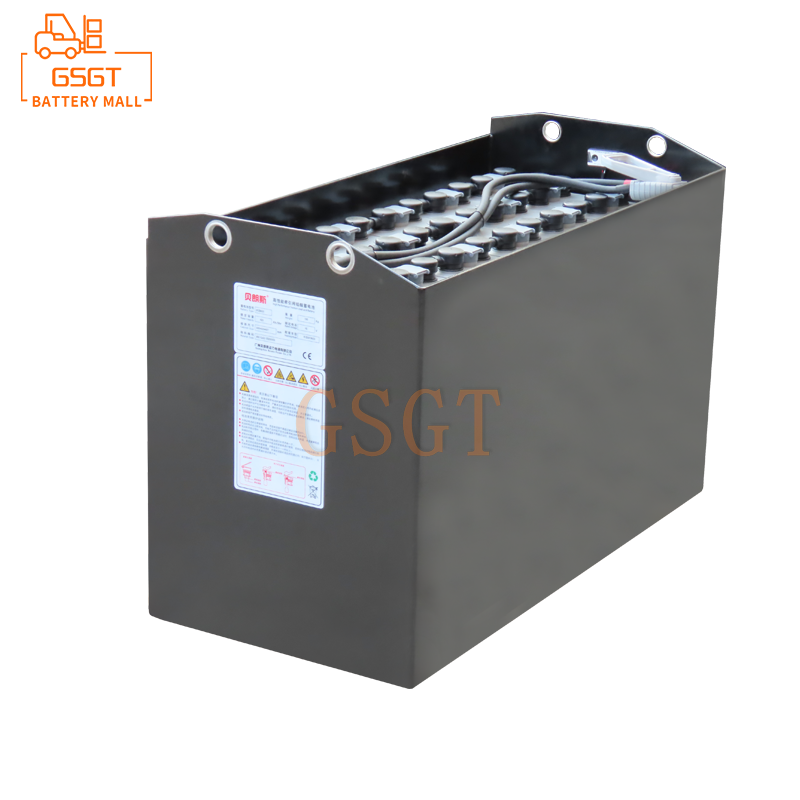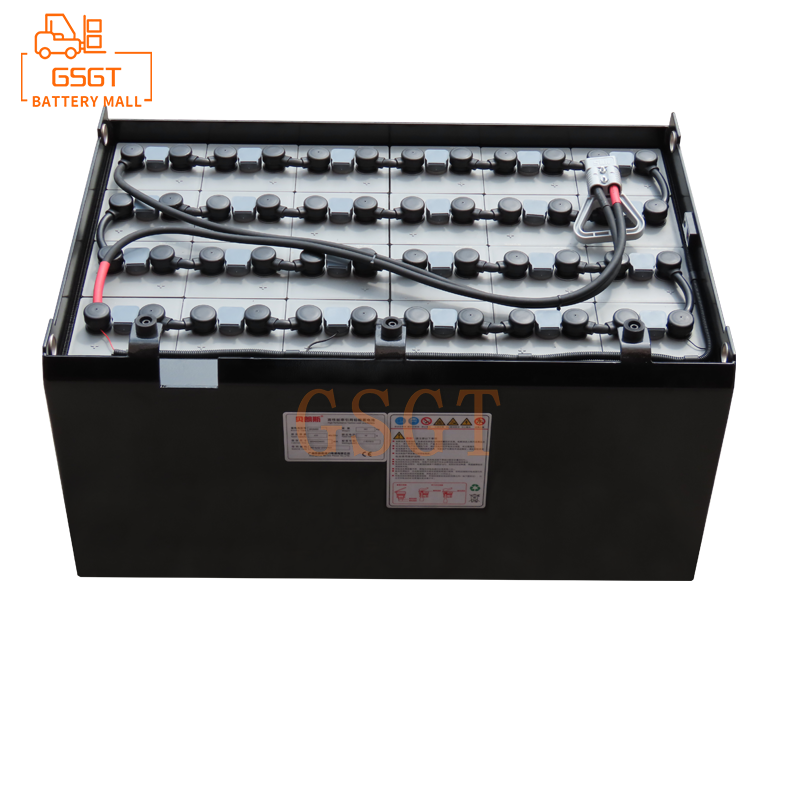Time:2025-04-01 10:06:23
Browse:736
In the operation of forklift, lead-acid battery as the core power source, its performance is directly related to the efficiency and stability of forklift. The performance of the battery is accurately reflected in the parameters. In-depth analysis of these parameters, like mastering the key to open the door of efficient operation of the forklift, can help the user to make the most appropriate choice.
Voltage: The "cornerstone" parameter of forklift power
●Basic knowledge: Lead-acid batteries are composed of multiple single-cell batteries in series, and each single-cell battery is usually rated at 2V. Common lead-acid batteries for forklifts can be combined with various voltage specifications, such as 24V, 36V, 48V, 60V, and even 80V, according to different application scenarios and forklift power requirements. This is like building a power building, the single cell battery is the basic "bricks", through different numbers of "bricks" in series, to build a voltage "height" that meets the needs of forklifts.
●Impact on forklift performance: voltage directly determines the output power of the forklift power system. In general, the higher the voltage, the stronger the power that the forklift can obtain, and the key performance indicators such as its driving speed, cargo lifting speed and climbing ability will be significantly improved. Taking the common 3-ton counterweight forklift as an example, when 48V lead-acid batteries are used, the full load driving speed on the flat ground can reach 18-20km /h, and after upgrading to the 60V voltage battery, the driving speed can be increased to 22-25km /h, and the lifting time of the goods can also be shortened by 10%-15%. This is because the higher voltage can provide a stronger driving force for the motor, making the forklift more efficient and agile during operation.
●Adaptation points: The selection of the right voltage must be closely combined with the type of forklift and the actual operation needs. For light electric pallet trucks, because of its light load and low operating speed requirements, 24V or 36V lead-acid batteries can meet the daily handling needs, and such low-voltage batteries are relatively low cost and easy to maintain. For large counterweight forklifts, forward forklifts, etc., due to the need to carry heavy goods, frequent lifting and operation in complex conditions, batteries with a voltage of 48V and above are the better choice to ensure that the forklift has enough power and stability.
Capacity: The "scale" of endurance
●Capacity definition: The capacity of the lead-acid battery, usually measured in ampere-hours (Ah), which indicates the amount of electricity that the battery can release under certain discharge conditions. For example, a lead-acid battery with a capacity of 400Ah can theoretically discharge continuously for 20 hours when discharged at 20A current. This is like the fuel tank capacity of the car, the greater the capacity, the further the vehicle can travel.
●The relationship between capacity and forklift endurance: During the operation of forklift, its power consumption is closely related to the operation intensity and duration. Large capacity lead-acid batteries can store more electricity, provide longer sustained power for the forklift, and significantly extend the range of the forklift. In places such as logistics warehouses, if forklifts need to carry goods continuously for a long time, such as working more than 8 hours a day, it is particularly important to be equipped with large-capacity batteries. Assuming that the average power consumption of a forklift truck is 50Ah per hour, the 400Ah capacity battery can support its continuous work for 8 hours, and if it is replaced with a 500Ah capacity battery, the battery life can be extended to 10 hours, reducing the charging frequency and improving the working efficiency.
●Selection considerations: When selecting the battery capacity, the operating environment, work intensity and operation route of the forklift should be fully considered. If the forklift truck frequently starts and stops in a small space and carries goods in a short distance, although the battery life requirements are relatively low, but because of the frequent start and stop, the battery needs to have a good instantaneous large current discharge ability, at this time, the battery with a slightly smaller capacity but superior discharge performance can be appropriately selected. On the contrary, for forklifts carrying out long-distance and high-intensity operations in open sites such as large logistics parks and ports, large-capacity batteries should be preferred to meet the needs of long-term continuous operation. At the same time, it is also necessary to consider the equipment of charging facilities, if the charging facilities are convenient, the excessive pursuit of battery capacity can be appropriately reduced, and the cost increase and space occupation caused by excessive capacity batteries can be avoided.
Cycle life: Battery "durability index"
●Cycle life concept: Cycle life refers to the lead-acid battery under certain conditions, from the fully charged state to the fully discharged state, and then back to the fully charged state, such a complete charge and discharge process is a cycle. When the battery capacity drops to 80% of the initial capacity, the number of cycles experienced is the cycle life of the battery. For example, a lead-acid battery with a cycle life of 1500 times, after 1500 complete charge and discharge cycles, its actual available capacity will be reduced to 80% of the initial capacity, and the performance of the battery has been greatly reduced, which may not meet the normal operation needs of forklifts.
●Factors affecting cycle life: The cycle life of forklift lead-acid batteries is affected by many factors. The first is the depth of charge and discharge, excessive discharge (the depth of discharge is too large) or overcharging will accelerate the aging and damage of the battery plate and shorten the cycle life. It is generally recommended that the discharge depth of the lead-acid battery of the forklift be controlled between 50% and 80% to avoid deep discharge. Secondly, the size of the charging current is also crucial, too large charging current will make the battery internal heat serious, resulting in electrolyte water loss, plate vulcanization and other problems, thereby reducing the cycle life. In addition, the use of ambient temperature has a significant impact on the cycle life, and the high temperature environment will accelerate the internal chemical reaction of the battery, which will aggravate the plate corrosion; The low temperature environment will increase the internal resistance of the battery, reduce the battery capacity, and shorten the cycle life. The ideal ambient temperature for use is about 25℃.
●Cycle life and cost effectiveness: Although the purchase price of lead-acid batteries with long cycle life is relatively high, the overall cost is lower in the long-term use. Take two forklift lead-acid batteries as an example, A battery cycle life is 1000 times, the price is 3000 yuan; B battery cycle life is 1500 times, the price is 4000 yuan. Assuming that the forklift needs 500 charge and discharge cycles per year, the A battery needs to be replaced once a year, and the cost is 3,000 yuan; The B battery is replaced twice every 3 years, and the average annual cost is about 2667 yuan. It can be seen that the selection of batteries with long cycle life can effectively reduce long-term use costs and improve economic benefits.
Internal resistance: the "invisible indicator" of battery performance
●Internal resistance meaning: The internal resistance of the lead-acid battery refers to the resistance of the current through the battery, which is composed of plate resistance, electrolyte resistance, partition resistance and connection bar resistance. The internal resistance is a relatively small value, usually measured in milliohm (mΩ). Although the value may seem small, it has an impact on battery performance that cannot be ignored.
●The effect of internal resistance on battery performance: The internal resistance is directly related to the charge and discharge efficiency of the battery. During the charging process, the internal resistance will cause electrical energy to be converted into heat energy, resulting in energy loss and heating of the battery. The greater the internal resistance, the greater the energy loss during charging, the lower the charging efficiency, and the more serious the battery heat, which may affect the service life of the battery. In the discharge process, the internal resistance will reduce the output voltage of the battery and affect the dynamic performance of the forklift. For example, when the internal resistance of the lead acid battery of the forklift increases, at the start moment, due to the large current, the voltage drop on the internal resistance will cause the motor end voltage to decrease significantly, making the forklift difficult to start, the driving speed is unstable, and the goods are weak to lift.
●Methods to reduce the internal resistance: In order to reduce the internal resistance of the lead-acid battery and improve the battery performance, you can start from many aspects. In the battery manufacturing process, the use of high-quality plate materials, optimization of electrolyte formula and improvement of partition structure can effectively reduce the internal resistance of the battery. For example, the use of high-purity lead alloy plates can reduce plate resistance; The new nano separator can reduce the resistance of the separator and improve the tightness and safety of the battery. In daily use, regular maintenance of the battery, such as checking the electrolyte level and density, timely replenishment of distilled water, to ensure that the electrolyte concentration is normal, but also help to keep the battery low internal resistance. In addition, reasonable control of charge and discharge current to avoid excessive current charge and discharge can also reduce the increase of internal resistance.
Interpretation of other key parameters
●Electrolyte density: Electrolyte density is one of the important parameters to measure the performance of lead-acid batteries. In general, a fully charged lead-acid battery has an electrolyte density between 1.28-1.30 g/cm³ (25 ° C). Too high electrolyte density will accelerate plate corrosion and shorten battery life; If the density is too low, the battery capacity will decrease. At different ambient temperatures, the electrolyte density will change, so it needs to be regularly tested and adjusted. For example, in the summer high temperature environment, the electrolyte density will decrease slightly, and sulfuric acid can be appropriately added to adjust; In the low temperature environment in winter, the electrolyte density will increase, and distilled water can be added for dilution to ensure stable battery performance.
●Self-discharge rate: The self-discharge rate refers to the rate at which the battery loses its own power due to the spontaneous chemical reaction inside the lead-acid battery in the open state. The lower the self-discharge rate, the better the storage performance of the battery. Under normal circumstances, the self-discharge rate of forklift lead-acid batteries is about 2%-5% per month. If the self-discharge rate is too high, there may be problems such as short circuit and impurity of electrolyte inside the battery, which need to be checked and maintained in time. In order to reduce the self-discharge rate, the battery can be stored in a cool and dry environment, avoid direct sunlight and high temperature environment, and periodically replenish the battery to keep the battery power sufficient.
The parameters of the lead-acid battery of forklift truck are interrelated and influence each other, which jointly determine the performance and applicability of the battery. In the selection of forklift lead-acid batteries, only by deeply understanding the meaning and function of these parameters, comprehensively considering the operating conditions, use environment and cost effectiveness of forklifts, can the most suitable batteries be accurately selected to provide a solid guarantee for the efficient and stable operation of forklifts.

$1105

$2450

$3810

$2180

MESSAGE
Professional And Efficient
Security
Affordable Price
Professional Services